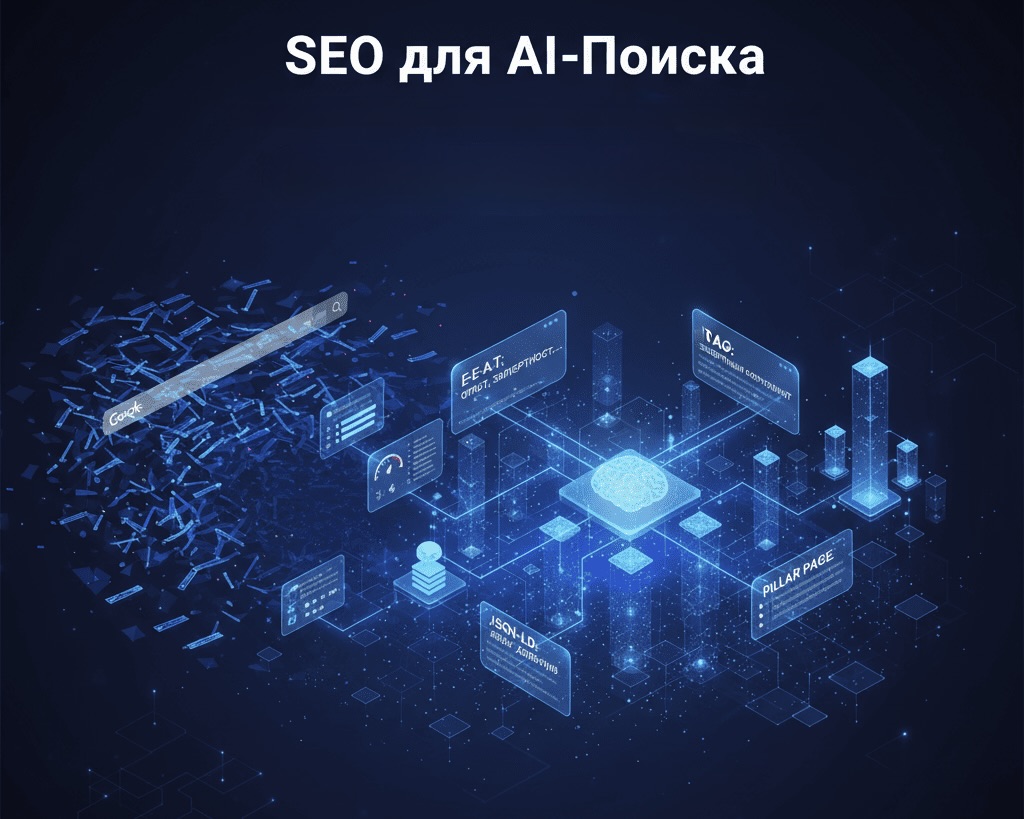SEO for AI Search: 5 Strategies to Become a Source, Not a Link

The New Era of Search: From Link to Source
Search is fundamentally changing. Instead of 10 blue links, users increasingly see a ready-made AI answer (this technology is called SGE, or Search Generative Experience). In this new reality, the winner is the site that becomes not just a link, but an authoritative source that the AI quotes directly.
Standard websites on builders (Tilda, Wix) are vulnerable. They are not technically equipped to "talk" to AI algorithms. The strategic answer is a site built on the principles of technical performance, semantic depth, and real expertise.
Below are 5 key strategies that define "TOP SEO" for the AI-search era.
1. E-E-A-T: The Foundation of Trust
The internet is flooded with "soulless" AI text. That's why Google uses E-E-A-T (Experience, Expertise, Authoritativeness, Trustworthiness) as a critical quality filter.
"Experience" has become the key factor. Content must demonstrate real-world, practical experience that an AI cannot fake. This means shifting from abstract descriptions to demonstrating measurable results (e.g., "we reduced audit costs by 75%").
This unique, non-replicable experience becomes the primary differentiation strategy. AI should be used not to generate "raw" text, but for post-processing: checking, optimizing, and, most importantly, embedding supporting data (metrics, graphs, case studies) into drafts.
2. Long-Tail Strategy: Content the AI is Forced to Cite
What is it? A focus on specific, long search phrases (Long-Tail Keywords) instead of general ones. For example, not "chatbot," but "chatbot for automating B2B review analysis."
Why it matters: The AI will generate its own summary answer for broad queries, "killing" traffic for them. However, to answer a hyper-specific, technical query, the AI will be forced to cite a single authoritative source—you. This strategy ensures less competition and attracts higher-quality, purchase-ready leads.
3. Pillar Page Architecture: Proving Topical Authority
What is it? Structuring your site as a "topic hub" (Pillar Page). Instead of 20 separate articles, you create one main page (the Hub) and 20 expert "spokes" (articles) that link back to it.
Why it matters: This "Hub and Spoke" model technically proves your Topical Authority. You are showing AI algorithms that you are an expert on the entire topic, not just one article. This strengthens the E-E-A-T for your whole site.
4. JSON-LD (Schema.org): The Language AI Understands Your Expertise In
What is it? A special "technical language" (JSON-LD) that "explains" to search engines what is on your page (this is a price, this is a name, this is a rating).
Why it matters: In search results, your site will be presented not as a simple link, but as an "enhanced" block, including ratings (stars), prices, or photos. This isn't a "gimmick"; it's how you technically prove your expertise and authoritativeness (part of E-E-A-T) to the AI. Standard builders can't do this at the required level. This leads to a Click-Through Rate (CTR) increase of up to 30%.
5. Load Speed: Guaranteeing Accessibility for AI
What is it? Instant loading of your website.
Why it matters: This isn't just for users (Google states a 1-second delay can cut conversions by 20%). AI models like SGE must crawl and process your content. Slow sites increase this processing cost for Google. Instant load speed is a signal of reliability and low crawl cost, giving you a technical advantage for being included in the AI's index.
Conclusion
These five strategies—Content (E-E-A-T), Semantics (Long-Tail), Architecture (Pillar Page), Technical Markup (JSON-LD), and Speed—are not separate options. They are components of a single, modern SEO strategy. This is the architecture required for your site to stop being just a "blue link" and become an "authoritative source" quoted by AI.
